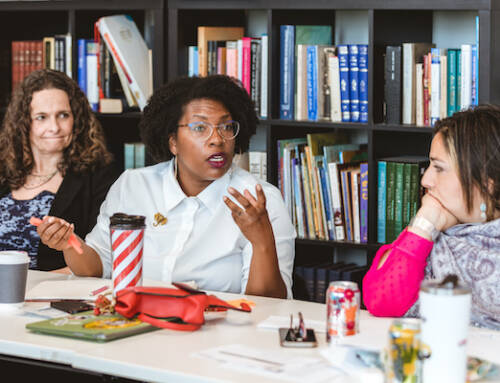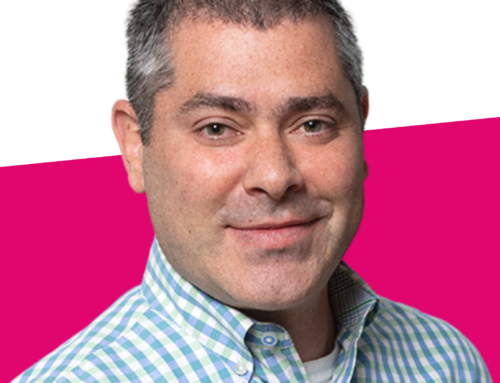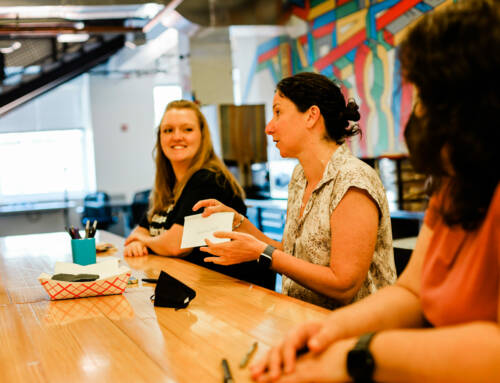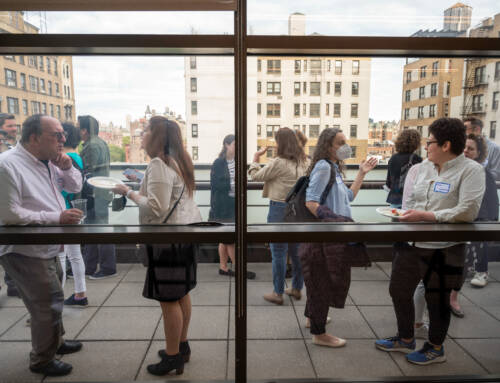Originally published in Gleanings, Summer 2018
“The answer is not ‘Build it and they will come’; it’s closer to ‘If they build it, they will come.’”
—CHIdush participant
How has our world changed from the 1950s until today, and how have our synagogue schools changed with it? At a retreat in Chicago, synagogue educators, clergy, and lay leaders armed with Post-it notes mapped out the shifts across decades in family structure, technology, education, and more—from Ozzy and Harriet of the 1950s to today’s Modern Family. The big “aha” from the era-mapping exercise? Despite dramatic shifts in our social, political, and cultural landscapes, our traditional synagogue education models haven’t always changed with them. The opportunity? To reimagine Jewish education in synagogues to meet today’s learners where they are and to expand our focus from surviving to thriving.
This mandate was at the heart of an 18-month change effort called CHIdush, undertaken by a forward-thinking network of synagogue teams in Chicago through a partnership between UpStart and the Jewish United Fund (JUF) of Metropolitan Chicago (made possible by the generous funding support of the Crown Family and The Jack and Goldie Wolfe Miller Fund). “The program allowed us to see that the world our kids are experiencing in their lives and in school doesn’t always square with what’s going on with synagogue learning,” noted Joy Wasserman, CHIdush project manager for JUF. CHIdush brought together seven diverse synagogue school teams to identify challenges and opportunities in their communities and to design meaningful solutions to them—drawing from bright spots locally and nationally. This piece will share stories of impact from the inaugural CHIdush cohort and highlight lessons learned for scaling success across a field of Jewish life.
AN APPROACH FOR SCALING IMPACT
The name “CHIdush” puts a Chicago spin on the Hebrew and Yiddish word for a new idea or insight. CHIdush established the conditions for these ideas to flourish by leveraging the foundational principles of Design Thinking and Adaptive Leadership through a methodology called Adaptive Design. Pioneered by UpStart cofounder and associate Maya Bernstein and Marty Linsky and laid out in their seminal Stanford Social Innovation Review article, Adaptive Design helps people generate new ideas in a way that integrates community needs, embraces creative experimentation, and produces rapid results—while equipping them to manage the change process.
At its heart, this process is deeply collaborative. In the context of Jewish education, Stanford education professor Ari Y. Kelman and Maya Bernstein, authors of “Working Across and Working Between,” suggest the best innovations thrive because they leverage the contributions of important stakeholders and create opportunities for them to work together toward a solution.
Through CHIdush, we integrated three layers of collaboration in order to scale success:
Collaborate with your learners:
Congregation Solel posed the design challenge: “How might we engage seventh graders in Jewish learning and community post–b’nai mitzvah?” According to Solel Cantor Jay O’Brien, students were “invited to be collaborators in building a seventh-grade, project-based, learning program,” shaping everything from the topics explored to the location and food to their interaction with the clergy. After each session, the CHIdush team met with the teens during gatherings called “Lifnot” (your turn) to receive real-time feedback and rapidly evolve their program design. Through CHIdush’s workshops, tools, and coaching, Cantor O’Brien’s team was able to build empathy with their learners, tap into their hopes and yearnings, and partner with them to imagine a better future. Cantor O’Brien credits recent increases in seventh-grade post–b’nai mitzvah retention to genuinely inviting learners to collaborate in building authentic Jewish experiences.
Collaborate with your community:
Anshe Emet Synagogue expanded their initial focus from redesigning a class for preschool families to a broader vision: “How might we create new pathways to Jewish life and community for young families?” This question led them to possibilities beyond the walls of the classroom, requiring the partnership and buy-in of an expanded group. Their success lay in their ability to embrace this approach wholeheartedly, using adaptive tools to collaborate with a diverse team of leaders, along with a robust advisory group made up of young families. “Working with partners and lay leaders and being intentional about getting their feedback was a game-changer for us,” said Maxine Segal Handelman, director of Family Life & Learning at Anshe Emet. (You can read more about Anshe Emet’s radical collaboration and rapid experimentation in developing their Little Builders program HERE.) This new way of working yielded not only new approaches to education, but also transformative changes to culture. As Rabbi Rachel Weiss of the Jewish Reconstructionist Congregation (JRC) of Evanston reflected, “Our entire congregation is asking, ‘How might we?’” This simple reframe has been a rallying cry for them to view challenges as opportunities, from redesigning their ritual practices to reimagining Jewish education.
Collaborate with your field:
CHIdush’s model centered around shared opportunities for learning and cross-pollination in order to accelerate success not just in one synagogue, but across a field. “Knowing there were others doing this work alongside us has inspired us,” said Dr. Roberta Goodman, education director of North Shore Congregation Israel (NSCI), where they are reimagining their fifth and sixth grade model to empower learners with more choice. “By doing this as part of a community process, we not only received resources and recognition, but also the permission to try new things and a framework to support us along the way.” Many participants were eager to drive change in their communities, but found that the CHIdush framework—team-based coaching, learning experiences with their peers, and community visibility—gave them the tools and hekhsher (stamp of approval) they needed to accelerate the success of their efforts. In addition to inspiration from peers, participants had opportunities to learn from “bright spots” across the field. For example, the CHIdush teams embarked on a “virtual visit” via video chat with Rachel Happel of Temple Beth Sholom of Needham, Massachusetts, who introduced teams to their innovative model and led them through a day in the life of her learners. These bright spots helped open up the network’s thinking to new possibilities, creating a bigger window to imagine what might be, extract principles of success, and express them in ways that met the needs of their own communities. The seventh-grade project-based learning model that Congregation Solel piloted was inspired in part by a “bright spot” from another community (Temple Beth Elohim’s “Omanut” program).
CHIdush itself was the result of a critical collaboration—between JUF and the participating congregations. While Federation involvement in synagogue education varies across the country, JUF realized its direct investment and energy could play a critical role in spurring innovation in the congregational education space. JUF recruited the cohort, gathered the needed resources, partnered with Upstart to work with the congregations, and committed to supporting the CHIdush congregations beyond the initial project. This type of collaboration gave the congregations access to resources that would not have been possible on their own and increased the probability that these efforts would achieve long-term sustainability.
BECOMING THE BRIGHT SPOTS
At the program’s closing siyyum (communal celebration), the synagogue teams again took to the wall, this time posting reflections on their transformative journeys. “I now believe we have a rubric for change—one based on creating partnerships among parents, learners, and educators,” wrote one participant. Perhaps this was the most important chidush to come out of the program—the realization that change can’t happen in a vacuum. It is collaboration across stakeholders that will ensure innovation efforts will truly take root.
Ultimately, CHIdush inspired a new cohort of synagogue leaders armed with the tools to create ongoing change. “We had the privilege of participating in a living educational laboratory, where the principles of design thinking are directly applied to the challenges of Jewish education based in synagogues,” noted Rabbi D’Ror Chankin-Gould of Anshe Emet Synagogue. “The only way the Jewish people can thrive is to take sincere risks and design a stronger future based on the wisdom we gain along the way.”
Linda Gerard, MBA, is the chief program and innovation officer at UpStart, which fuels and amplifies the powerful ideas of the Jewish community’s social entrepreneurs, providing them with the tools and network they need to build a better tomorrow.
Rabbi Scott Aaron, PhD, is the executive director of the Community Foundation for Jewish Education of the Jewish United Fund / Jewish Federation of Metropolitan Chicago. JUF is the one Chicago organization that impacts every aspect of local and global Jewish life, providing human services for Jews and others in need, creating Jewish experiences and strengthening Jewish community connections. emergency locksmith service
Our purpose is to enable entrepreneurs to bring bold Jewish ideas to light. We help them reach Up to people in new ways that are meaningful, more inclusive, and create a brighter future for our Jewish community and the world we share.





